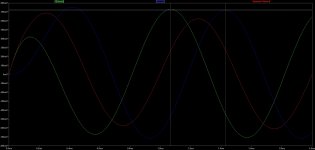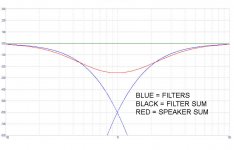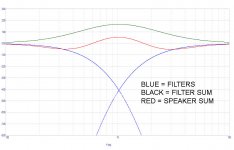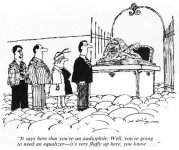Indeed, you can probably get it within a dB without too much effort.
Ref to Post 370 again.
This is the situation at 1 kHz. The woofer is lagging the tweeter by some ~380 us. The crossover should [somehow] compensate for this situation.

Attachments
Ref to Post 370 again.
This is the situation at 1 kHz. The woofer is lagging the tweeter by some ~380 us. The crossover should [somehow] compensate for this situation.

The crossover is intended to make summed response at the crossover point flat.
The phase response of the woofer with respect to the tweeter is a different matter. That the woofer lags the tweeter is not surprising .
Of course.
As mentioned earlier the sum gives a 4 dB notch at 1 kHz. NP encouraged us to find a set of values for the crossover shown in post 370 to flatten that. The numbers I mentioned is part of the facts one has to work with. Maybe I stated the obvious, but it was to get to a better second order filter.
As mentioned earlier the sum gives a 4 dB notch at 1 kHz. NP encouraged us to find a set of values for the crossover shown in post 370 to flatten that. The numbers I mentioned is part of the facts one has to work with. Maybe I stated the obvious, but it was to get to a better second order filter.
As mentioned earlier the sum gives a 4 dB notch at 1 kHz. NP encouraged us to find a set of values for the crossover shown in post 370 to flatten that. The numbers I mentioned is part of the facts one has to work with.
Here's a cheap example, a 2 pole pair of filters which sum flat at 1 KHz
but paired with drivers that roll off at 500 Hz (tweeter) and 2 KHz
(woofer).
If we play with the values a bit, we improve it to about +/- .5 dB.
You can probably do better than that, this took me a minute.
Attachments
Here's a cheap example, a 2 pole pair of filters which sum flat at 1 KHz
but paired with drivers that roll off at 500 Hz (tweeter) and 2 KHz
(woofer).
If we play with the values a bit, we improve it to about +/- .5 dB.
You can probably do better than that, this took me a minute.
You are smarter and faster than me, sir!

Will this work with Quad ESLs and OB subwoofers?
I purchased the First Watt B5 for the sole purpose of integrating dipole subs with the ESL 57. It works amazingly well. It's also quite cost effective by my reckoning, because amplifiers that can are transparent enough to do justice to the Quads AND can control the panels at low frequencies tend to be... expensive. With a high pass filter in the mix, my little EL84 amps do a much better job with the Quads. You of course have a lot of parameters to experiment with in the crossover point. I like 80hz second order the best.
Right now, I'm using a full range driver instead of the Quads - they're great, but the Quads are greater and I'm going to repair them soon and put them back in service.
This might be some kind of a "philosophical question".
A crossover intended to cross between a subwoofer (or two) and some full range speaker like a Quad, Martin/Logan or a Maggie, could as well be designed with some integrated circuit operational amplifier for the low pass part while the high pass part of it could use the Toshiba JFETs. As long as you have your crossover just up to a few hundred Hertz. If you cross at 1 - 2 - 3 - 4 kHz it is anotherthing.
Fun with JFETs, but they could be saved from crossing basses, dipole compensation and so on.
A crossover intended to cross between a subwoofer (or two) and some full range speaker like a Quad, Martin/Logan or a Maggie, could as well be designed with some integrated circuit operational amplifier for the low pass part while the high pass part of it could use the Toshiba JFETs. As long as you have your crossover just up to a few hundred Hertz. If you cross at 1 - 2 - 3 - 4 kHz it is anotherthing.
Fun with JFETs, but they could be saved from crossing basses, dipole compensation and so on.
When should I start refreshing diyaudio store page?
Need a little help here. I'm in Madison, WI, and I've been refreshing the page several times every hour since about June 8, but I'm running dangerously low on food, water, TP and the like. I really need to get out of the house today and restock (especially the TP) and I wonder if anyone local might be available to come over and hit the refresh button for me for just a couple of hours.
Need a little help here. I'm in Madison, WI, and I've been refreshing the page several times every hour since about June 8, but I'm running dangerously low on food, water, TP and the like. I really need to get out of the house today and restock (especially the TP) and I wonder if anyone local might be available to come over and hit the refresh button for me for just a couple of hours.
I believe they are working on your TP issue. NP wrote this: "The base kit of the crossover available from the diyAudio store includes the PC board and 16 matched Jfets as well as 16 resistors chosen to trim the Jfets into the desired load line."
- Status
- This old topic is closed. If you want to reopen this topic, contact a moderator using the "Report Post" button.
- Home
- Amplifiers
- Pass Labs
- Pass Labs B4 crossover questions






